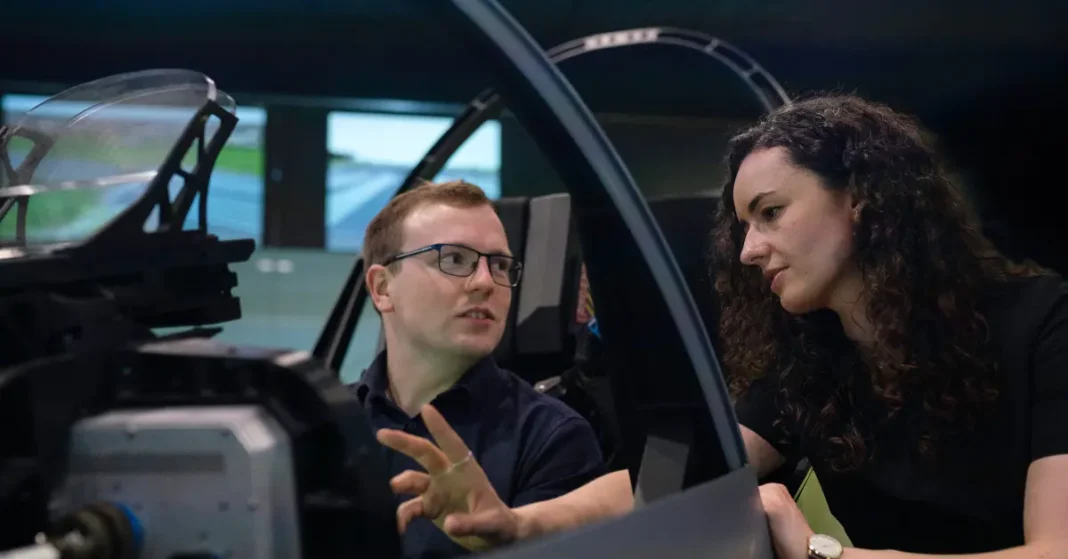The allure of the skies has called to many, but the journey to join the ranks of pilots comes with a tapestry of stringent requirements, especially where vision is concerned. Vision is a pilot’s most vital sense, and the ability to see clearly and accurately is non-negotiable when it comes to the safety and efficacy of flight operations.
In this blog, we’ll navigate the visual standards set by aviation authorities, detailing how they reconcile the necessity for impeccable visual acuity with the realities of human variability. From the clear distinction between uncorrected and corrected vision to the specific demands of near and distant acuity, we will investigate every facet of the visual benchmarks that aspiring pilots must meet. Furthermore, the profound impact of corrective lenses on a pilot’s performance will be scrutinized, examining the delicate balance between visual aids and flight safety.
Table of Contents
Can I still be a pilot if I wear glasses?
Yes, individuals who wear glasses or contact lenses can pursue a career as a pilot. Many pilots rely on corrective lenses, and most regulatory bodies deem this completely acceptable, provided that your vision aligns with the necessary standards.
It’s important to note that the aviation industry recognizes the prevalence of individuals requiring visual correction and accommodates them within established guidelines. Pilots are subject to regular eye examinations to ensure their vision remains within the acceptable range, emphasizing both the inclusivity of the profession and the commitment to maintaining rigorous safety standards.
Can I become a pilot with bad eyesight?
While perfect eyesight isn’t always mandatory, aspiring pilots must meet specific vision requirements. These standards vary based on the desired license type and regional aviation regulations. Fortunately, corrective measures like glasses or contacts are widely accepted, though limitations may apply depending on the degree of vision impairment.
To receive accurate and personalized information, consulting an aviation medical examiner or the relevant aviation authority is crucial. With advancements in vision correction technology, even individuals with more significant challenges may find pathways to fulfilling their flying dreams.tunesharemore_vertadd_photo_alternate
Do you still need perfect vision to be a pilot?
No, having perfect vision is not a strict requirement to become a pilot. However, you must meet the specific vision standards established by the aviation authority in your region and the type of pilot’s license you are aiming for.
Can you be a pilot with glasses in the navy?
Yes, individuals with glasses can pursue a career as a Navy pilot. The Navy permits pilots to wear glasses or contact lenses, provided they meet specific vision criteria, including an uncorrected visual acuity of 20/50 or better in each eye, corrected visual acuity of 20/20 or better in each eye, and normal color vision.
Is Lasik allowed for pilots?
LASIK surgery is typically permitted for pilots, including by aviation authorities like the FAA, with some important considerations. Pilots undergoing LASIK can achieve 20/20 vision without glasses, but a recovery period of around 6 weeks is required before resuming flying duties. During this time, follow-up examinations are necessary to ensure proper healing and vision stability.
Specific regulations, such as submitting a report from the ophthalmologist, may exist, and pilots should review the requirements of their country’s aviation authority. While LASIK is generally safe, pilots should be aware of potential risks, including dry eye and vision fluctuations, and discuss these with their ophthalmologist before deciding on LASIK.
Visual Standards for Pilots
In the world of aeronautics, the proficiency of a pilot is not solely dictated by their ability to maneuver an aircraft or their adeptness at interpreting avionic instrumentation. A fundamental component of a pilot’s capability resides within the faculty of sight. Visual acuity—defined as the clarity or sharpness of vision—is paramount in ensuring that operators of aircraft can perform their duties with the highest degree of safety and efficiency. This discussion elucidates the stringent visual acuity requirements that are essential for pilots, elucidating both the standards set forth by regulatory authorities and the underlying rationale for these requisites.
The Federal Aviation Administration (FAA), along with its global counterparts like the European Union Aviation Safety Agency (EASA), posits specific visual acuity guidelines for pilots. There are three classes of medical certificates for pilots in the United States: First-Class for airline transport pilots, Second-Class for commercial pilots, and Third-Class for private and recreational pilots.
For a First-Class medical certificate, applicants must possess 20/20 or better distant vision in each eye separately, with or without correction (glasses or contact lenses), and 20/40 or better near vision measured at 16 inches, also in each eye separately with or without correction. Intermediate vision requirements must be met as well. The standards for Second-Class and Third-Class medical certificates are similar regarding distant vision, but slightly less stringent for near and intermediate vision.
Color vision is another critical aspect of visual acuity, as pilots must be able to recognize and distinguish appropriately between colors that are pertinent to air navigation, particularly about light signals and map reading. A deficiency in color perception may not be an outright disqualification, but it will prompt further evaluation and potentially impose limitations on the pilot’s certification.
Depth perception, while not as frequently discussed as distant or color vision, is another requisite attribute. The ability to accurately perceive the relative distance of objects in three-dimensional space is vital during various phases of flight, especially when landing. Applicants must demonstrate adequate depth perception as per the testing protocols of the examining aviation medical examiner.
It is important to underscore that in the case of pilots who do not initially meet these standards, options such as corrective surgery have become increasingly accessible and can potentially aid in meeting the necessary visual acuity benchmarks. The progression in ophthalmic procedures and adaptive technologies has broadened the horizons for many aspiring aviators.
Periodic re-evaluation is mandatory for all certification classes, ensuring that a pilot maintains the requisite visual standards throughout their career. The intervals for such evaluations are tailored to the class of certification and the age of the pilot.
In summary, the scrupulous regulations governing visual acuity for pilots are emblematic of the conscientious approach adopted by aviation authorities to uphold the safety and well-being of not just the operators but also the passengers and the broader public. These standards are not arbitrary but rather the product of meticulous research and decades of experience that seek to preserve the integrity of a pilot’s most valuable navigational asset—their vision.
Corrective Lenses and Flight Safety
The provision and implementation of corrective lenses are vital factors in maintaining the high safety and performance standards required in aviation. Corrective lenses, which may include glasses or contact lenses, serve to amend the deficiencies in a pilot’s visual acuity, ensuring adherence to rigorous aviation standards.
It is well understood that the successful operation of an aircraft hinges upon a pilot’s ability to accurately perceive and interpret visual information, both at a distance and close range. This includes but is not limited to, navigating by visual references, reading instruments and screens in the cockpit, identifying air traffic, and perceiving potential hazards during flight operations. Failure to correctly interpret such visual data can lead to errors with catastrophic implications.
Consider the integration of corrective lenses in aviation – their impact on safety is multi-fold. Corrective lenses prescribed for pilots are meticulously tailored to address the individual’s specific vision deficits, thus enabling the pilot to achieve the precise visual acuity necessary for flight. These lenses must be designed to withstand the unique conditions found in the cockpit, such as variable lighting and atmospheric pressure changes, without distorting vision or dislodging from their position.
Furthermore, the lenses play a significant role in the mitigation of eye fatigue, a common occurrence among pilots due to prolonged periods of intense visual focus during flight operations. Eye fatigue can lead to decreased reaction times and impaired judgment. Corrective lenses that accurately compensate for refractive errors reduce the strain on the pilot’s visual system, thus directly contributing to prolonged alertness and optimal performance.
The choice between glasses and contact lenses is another consideration. While glasses are often easier to manage and less prone to complications, they can present issues such as reflections, fogging, and potential interference with headgear or oxygen masks. Meanwhile, contact lenses, although not encumbered by such frame-related issues, carry their risks including eye dryness exacerbated by the dry cabin air and the potential for dislodgement which could lead to a sudden, detrimental impact on vision.
Materials and coatings utilized in corrective lenses are also subjected to rigorous assessment to ensure maximum clarity, anti-reflective properties, shatter resistance, and compatibility with cockpit instruments’ displays, which often utilize polarized light sources. Lenses that do not comply with these technical specifications could introduce glare or other visual artifacts that degrade a pilot’s ability to perform safely.
Corrective lenses also have a significant impact on a pilot’s depth perception – a crucial element in spatial orientation, glide path alignment during landing, and avoidance of obstacles. Inadequate correction can lead to misjudgments in distance or speed, thereby complicating operations and potentially jeopardizing the safety of the aircraft.
It is incumbent upon aerospace medicine specialists and optometrists to work closely with pilots in not only correcting their visual deficiencies but also ensuring that the corrective devices do not introduce new complications in the flight deck. The careful selection and fitting of these lenses is paramount to ensuring that pilots can both meet the vision standards set forth by aviation authorities and perform their duties without visual encumbrance.
Thus, the impact of corrective lenses on a pilot’s safety and performance is an intricate synthesis of design, material science, human factors, and medical acuity, working cohesively to fortify the pilot’s most relied-upon sense – vision.
As technology and our understanding of human physiology progress, so too must the sophistication with which we approach corrective lens design and application in aviation. The commitment to pilot visual acuity through proper corrective measures is not merely a regulatory obligation but a fundamental component of the aviation safety framework.
The Role of Regular Eye Examinations
Regular eye examinations hold paramount importance for pilots, particularly those necessitating corrective lenses. Accurate visual perception is the linchpin of aviation safety. Pilots must continuously monitor a myriad of instruments, often while simultaneously surveilling the airspace outside the cockpit, where resolving power and clarity can mean the difference between a safe flight and one fraught with peril.
Corrective lenses for pilots serve not merely to correct substandard vision but to sharpen the pilot’s overall visual performance to meet stringent aviation standards. These lenses must be tailored to address individual vision deficits, compensating for nearsightedness, farsightedness, astigmatism, or presbyopia. The precision in tailoring these lenses is non-negotiable, directly impacting a pilot’s safety and performance.
Over time, even the most meticulously prescribed corrective lenses may not serve their intended purpose if refractive errors progress or change. Regular examinations mitigate this risk by identifying shifts in visual acuity and addressing them before they can compromise a pilot’s capacity to perform. Furthermore, such examinations are vital in the mitigation of eye fatigue, a common predicament for aviators, which can be exacerbated by inaccurately compensating for refractive errors.
The choice between glasses and contact lenses for pilots is another pivotal consideration in aviation ophthalmology. Each option carries its own set of advantages and potential drawbacks, especially concerning the cockpit’s pressurized and sometimes arid environment, which can affect lens comfort and eye hydration.
Optical materials and coatings are meticulously selected to maximize clarity and compatibility with the flight deck’s unique lighting conditions and heads-up displays. Anti-reflective coatings and specific tints can minimize glare and enhance contrast, crucial for accurately reading instruments and navigating in variable lighting scenarios. Additionally, the impact of corrective lenses on depth perception and spatial orientation further underscores the need for impeccable fitting and prescription accuracy.
Collaboration between aerospace medicine specialists, optometrists, and pilots ensures an interdisciplinary approach to visual acuity. Such collaboration facilitates the integration of design, material science, human factors, and medical acuity, driving the development and calibration of corrective lenses designed specifically for aviators.
Careful selection and fitting are further underscored due to the dynamic and three-dimensional environment in which pilots operate. The corrective lenses must integrate seamlessly into this environment, supporting the pilot’s need to transition focus rapidly between near and distant objects, often under variable illumination and high-stress conditions.
Ultimately, the rigor applied to the creation and maintenance of corrective lenses for pilots reflects a broader commitment: that of pilot visual acuity as an indispensable component of aviation safety. Regular eye examinations serve as the fulcrum upon which this commitment balances, ensuring that those entrusted with the lives of others while aloft are visually equipped to navigate the skies with precision and confidence.
Advances in Vision Correction Technology
In the high-stakes realm of aviation, the accuracy of a pilot’s visual perception is not merely a matter of convenience; it is an imperative for operational safety and efficiency. Evolving technologies in vision correction are playing a pivotal role in maintaining this visual acuity among aviators, ensuring that the stringent demands of aerial navigation and aircraft operation can be met with precision.
Corrective lenses, an essential tool for many pilots with refractive errors, have seen significant advancements. These lenses are no longer generic implements; they are highly customized visual aids, meticulously tailored to address the specific deficits in an individual’s vision, thereby enhancing the clarity and sharpness of the visual field. This level of customization is vital, as it directly influences a pilot’s ability to perform tasks such as accurately reading instrumentation, discerning distant objects, and interpreting visual cues during flight.
The safety and performance benefits of corrective lenses in aviation are substantial. Accurately compensating for refractive errors is critical not only for the prevention of visual misinterpretations but also for the mitigation of eye fatigue—a common malady among aviators that can lead to diminished reaction times and impaired decision-making abilities.
When considering the options—glasses versus contact lenses—for vision correction in aviation contexts, several factors must be scrutinized. This includes the potential dislodging of glasses during rapid movements, the risk of dry eyes from cabin pressure changes affecting contact lens comfort, and the way corrective devices interact with headsets and oxygen masks. In the minutiae of these considerations lies the potential impact on a pilot’s ability to maintain optimal visual function.
The material from which lenses are crafted and the application of specialized coatings are also subjects of meticulous selection processes. Optimal optical substrates and anti-reflective, scratch-resistant, and anti-fog coatings are employed to ensure the lenses provide maximum clarity without interference from the cockpit’s multifaceted light environments.
Furthermore, the impact of corrective lenses on depth perception and spatial orientation cannot be understated. Anomalies in these areas may compromise a pilot’s ability to judge distances or navigate through three-dimensional space, necessitating corrective lenses that provide not just visual acuity but also a true representation of spatial relationships.
Collaborative efforts between aerospace medicine specialists, optometrists, and pilots are fundamental in tailoring corrective lens solutions. This multidisciplinary approach ensures the amalgamation of practical in-flight experience with advanced ophthalmic expertise, resulting in vision correction that is both scientifically sound and operationally applicable.
An essential aspect of this inter-disciplinary synergy is the careful selection and fitting process of corrective lenses. A meticulous approach is essential to account for unique cockpit conditions, such as changes in lighting, atmospheric pressure, and the high visual demands of aviating.
The confluence of design innovation, material science, human factors engineering, and clinical acuity in the application of corrective lenses serves as a testament to the commitment to maintain, if not enhance, pilot visual acuity. The integration of these lenses into the dynamic and demanding environment of the pilot must reflect both the technical sophistication and the practical understanding of aviation operations.
The current trajectory of vision correction technology echoes a resolute commitment to uphold visual acuity as a non-negotiable cornerstone of aviation safety. Advancements in optics and materials science are recalibrating the potential for pilots to achieve and sustain the visual standards necessary for the safe conduct of flight operations.
With the pursuit of visual excellence as a guiding principle, the implications of these evolving technologies extend beyond the immediate horizons of individual pilots to the broader realm of aviation safety, contributing to an increasingly secure and efficient airspace.
As the horizon of aviation continues to expand, so does the technological landscape of vision correction, offering new vistas of opportunity for those who once might have been grounded by their eyesight. The journey through the various optic criteria and compensatory measures for pilots reveals a dynamic interplay between unyielding standards and innovative solutions.
The vigilance in regular eye examinations and proactivity in adapting to vision changes not only ensures the longevity of pilot careers but also cements the safety of the skies. Ultimately, the future of aviation holds a promise of inclusivity, where those with the determination to fly can find a place in the cockpit, aided by an ever-improving arsenal of vision correction tools and techniques.





